stop start CHEVROLET MONTE CARLO 1981 4.G Owners Manual
[x] Cancel search | Manufacturer: CHEVROLET, Model Year: 1981, Model line: MONTE CARLO, Model: CHEVROLET MONTE CARLO 1981 4.GPages: 104, PDF Size: 23.92 MB
Page 20 of 104

Downloaded from www.Manualslib.com manuals search engine SECTION 2
STARTING AND OPERATING
ENGINE EXHAUST GAS CAUTION
(CARBON MONOXIDE)
Do not breathe exhaust gas because it contains carbon monoxide, which by
itself has no color or odor. Carbon monoxide is a dangerous gas. It can cause
unconsciousness and can be lethal.
If
at any time you think exhaust fumes are entering the vehicle, have the cause
determined and corrected
assdon.as possible. If you must drive under. lhese conditions , drive only wilh All windows fully OPEN .
To allow proper operation of your vehicle's ventilation system, keep the.air inlet grille in front of the windShield clear of snow, leaves or other obstructions at all
times.
Protect against carbon monoxide entry into the vehicle body . The best way is to keep the engine exhaust system, vehicle body and body ventilation system
properly maintained. We recommend that the exhaust system and body be inspected by a competent lechniclan :
•
each time the vehicle is raised for an oil change;
• whenever a change is noticed in the sound of the exhaust system;
• whenever the exhaust system, underbody or rear of the vehicle is damaged or. becomes corroded .
See your Miiintenance Schedule folder for parts recuiring inspection.
To allow proper operation of your vehicle's ventilation system, keep the air inlet
grille
in front of the windshi~1d clear of snow, leaves or other obstructions at all
times.
Do not perk or idle this vehicle for more than 10 minutes with the ventilation
system control switch in the "off" position while the engine is running . Even
with
the ventilation system on, running the engine while parked is not recommended . Entry of carbon monoxide into the vehicle body is possible with
a
poorly repaired , damaged, or corroded exhaust system or body.
Do
not run the. engine in CONFINED areas (such as garages or next to a
building) any more than needed to move the vehicle . When Ih.e vehicle has to be stopped in an UNCONFINED area with the engine running for any more
than a few minutes, take the following stepa :
A. Adjust the heating
or cooling ' system to force outside air into the vehicle as
follows:
1. On vehicles not ecuipped wijh air condijioning, set the fan to medium or high speed and the upper control lever to any position except
"Off."
2. On vehicles ecuipped with air conditioning , set the fan to medium or
high speed and the upper control lever to any position except "Off" or
"Max., "
B . Keep the exhaust tailpipe area clear 01 snow and other material to help
reduce the
buildup 01 exhaust gases under the vehicle.
Page 21 of 104
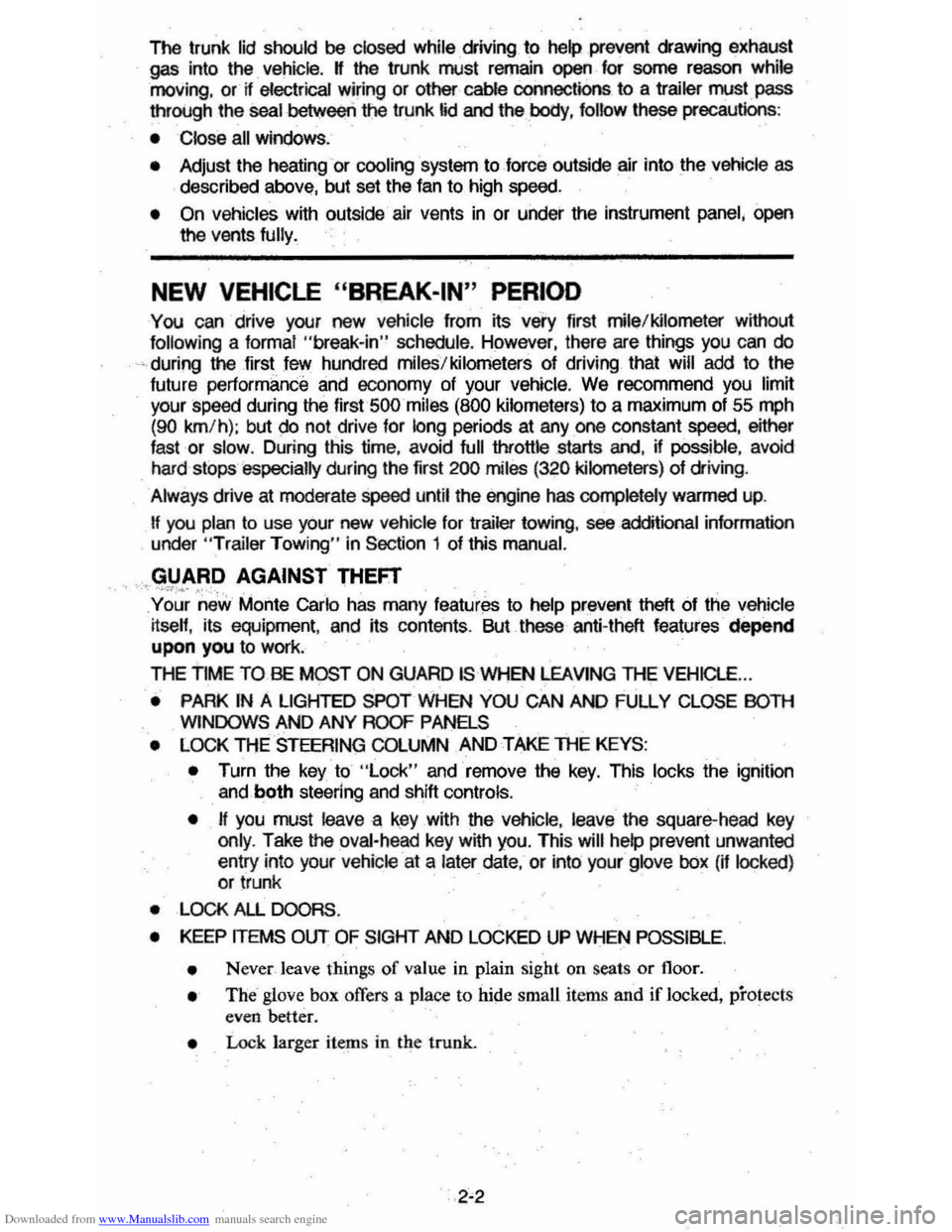
Downloaded from www.Manualslib.com manuals search engine The trunk lid should be closed while driving to help prevent drawing exhaust gas into the vehicle. If the trunk must remain open for some reason while
moving . or ff electricai wiring or other cable conneclionS to a trailer must pass through the sealbelweeri the trunk lid and the body, follow these precautionS :
• Close all windows.
• Adjust the heating or cooling system to force outside air into the vehicle as
described above. but set the fan to high speed .
• On vehicles with outside ' air vents in or under the instrument panel ; open
the vents
fully.
NEW VEHICLE "BREAK-IN" PERIOD
You can drive your new vehicle from its very first mile/kilometer without
following a formal "break-in" schedule. However. there are things you can do during the first few hundred miles/kilometers of driving . that will add to the
future performance and economy of your
vehicle. We recommend you limit
your speed during the first 500 miles (800 kilometers) to a maximum of 55 mph (90 km /h) ; but do not drive for long periods at anyone constant speed. either
fast or
slow. During this time. avoid full throttle starts and. if possible. avoid
hard stops especially during the first 200 miles (320 kilometers) of driving .
Always drive at moderate speed until the engine has COfl'4lletely warmed up.
If you plan to use your new vehicle for trailer towing . see additional information
under " Trailer Towing" in Section 1 of this manual.
GUARD AGAINST THEFT
y~~; '~ew Monte carlo has many features to help prevent theft of the vehicle
itself.
its equipment. and its contents. But these anti-theft features depend
upon you to work.
THE
TIME TO BE MOST ON GUARD ISWHEN LEAVING THE VEHICLE ...
• PARK IN A LIGHTED SPOT WHEN YOU CAN AND FULLY ClOSE BOTH WINDOWS AND ANY ROOF PANaS
• LOCK THE STEERING COLUMN AND TAKE THE KEYS:
•
Turn the key to "Lock " and remove the key. This locks the ignition
and both steering and shift controls.
• If you must leave a kilY with the vehicle . leave the square-head key only. Take the oval· head key with you. This will help prevent unwanted
entry into your
vehicle at a later date . or into your glove box (if locked) or trun k
• LOCK ALL DOORS .
•
KEEP ITEMS OUT OF SIGHT AND LOCKED UP WHEN POSSIBLE.
• Never leave things of va lue in plain sight on seats or floor.
• The glove box otTers a place to hide small item s and if locked, protects even better.
• Lock larger item s in the trunk.
Page 23 of 104
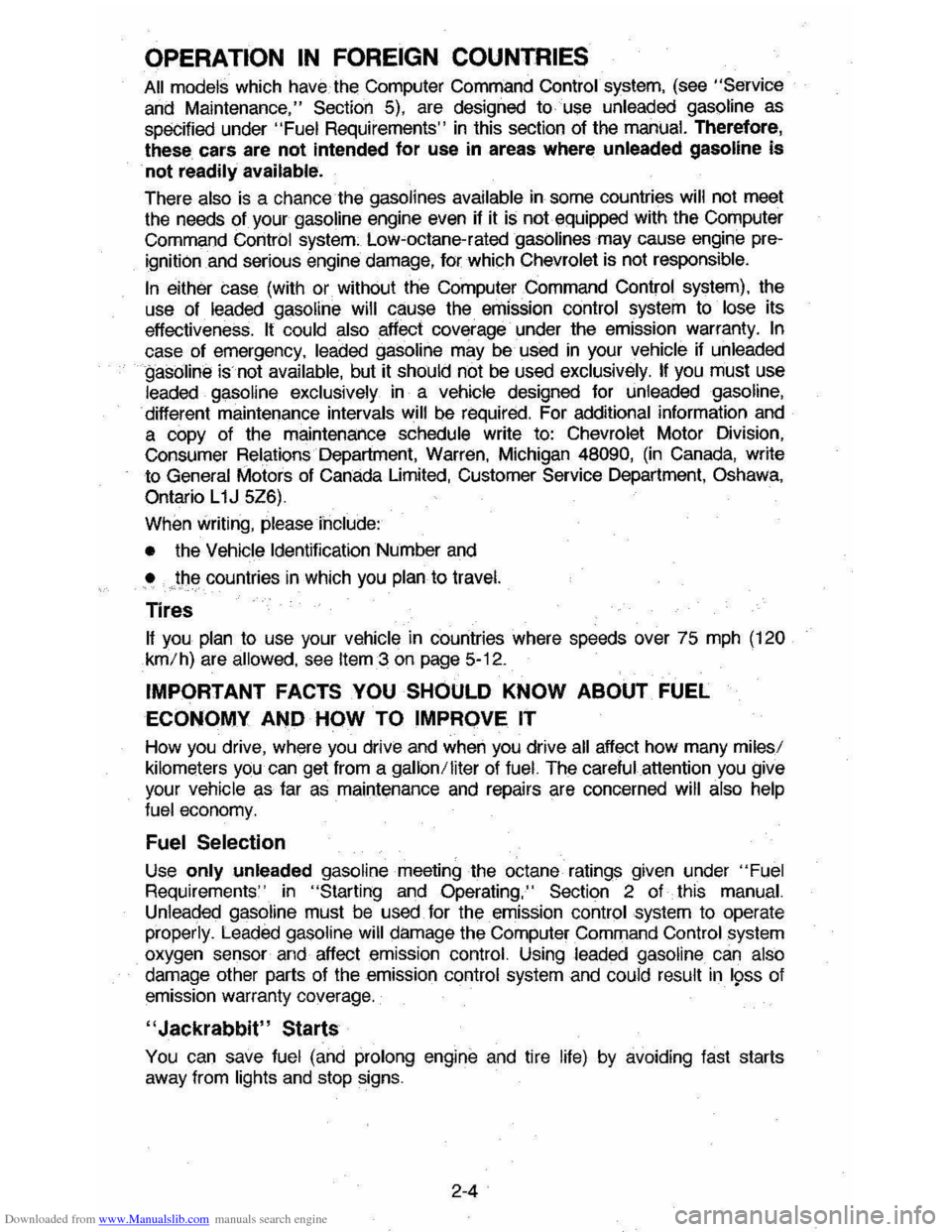
Downloaded from www.Manualslib.com manuals search engine OPERATION IN FOREIGN COUNTRIES
All models which have the Computer Command Control system, (see "Service
and Maintenance," Section 5), are designed
to use unleaded gasoline as
specified under
"Fuel Requirements" in this section of the manual. Therefore,
these cars are not intended for use in areas where unleaded gasoline is
not readily available,
There also is a chance the gasolines available in some countries will not meet the needs of your gasoline engine even if it is not equipped with the Computer
Command Control system; Low~octane-ratedgasolines may cause engine pre
ignition and serious engine damage, for which Chevrolet is not responsible.
In either case (with or without the Computer Command Control system), the
use of leaded gasoline will cause the emission control system to lose its
effectiveness.
It could also affect coverage· under the emission warranty. In
case of emergency, leaded gasoline may be used in your vehicle if unleaded gasoline is not available, but it should not be used exclusively. If you must use
leaded gasoline exclusively
in a vehicle designed for unleaded gasoline,
different maintenance intervals will be required. For additional information and
a copy of the maintenance schedule write to: Chevrolet Motor Division, Consumer Relations Department, Warren, Michigan 48090, (in Canada, write
to General Motors of Canada Limited, Customer Service Department, Oshawa,
Ontario
L 1J 5Z6).
When writing, please
include:
•
the Vehicle Identification Number and
• the countries in which you plan to travel.
Tires
If you plan to use your vehicle in countries where speeds over 75 mph (120
km/h) are allowed, see lIem3 on page 5-12.
IMPORTANT FACTS YOU SHOULD KNOW ABOUT FUEL
ECONOMY AND HOW
TO IMPROVE IT
How you drive, where you drive and when you drive all affect how many miles/
kilometers you can get from a galion/liter of fuel. The careful attention you give
your vehicle as far as maintenance and repairs are concerned
will also help
fuel economy.
Fuel Selection
Use only unleaded gasoline meeting the octane ratings given under "Fuel Requirements" in "Starting and Operating," Section 2 of this manual.
Unleaded gasoline must be used. for the. emission control ,system to operate
properly. Leaded gasoline will damage the Computer Command Control system
oxygen sensor and affect emission control. Using leaded gasoline can also
damage other parts of the emission control system and
CQuld result in 19s8 of
emission warranty coverage.
"Jackrabbit" Starts
You can save fuel (and prolong engine and tire life) by avoiding fast starts
away from lights and stop signs.
2-4
Page 24 of 104
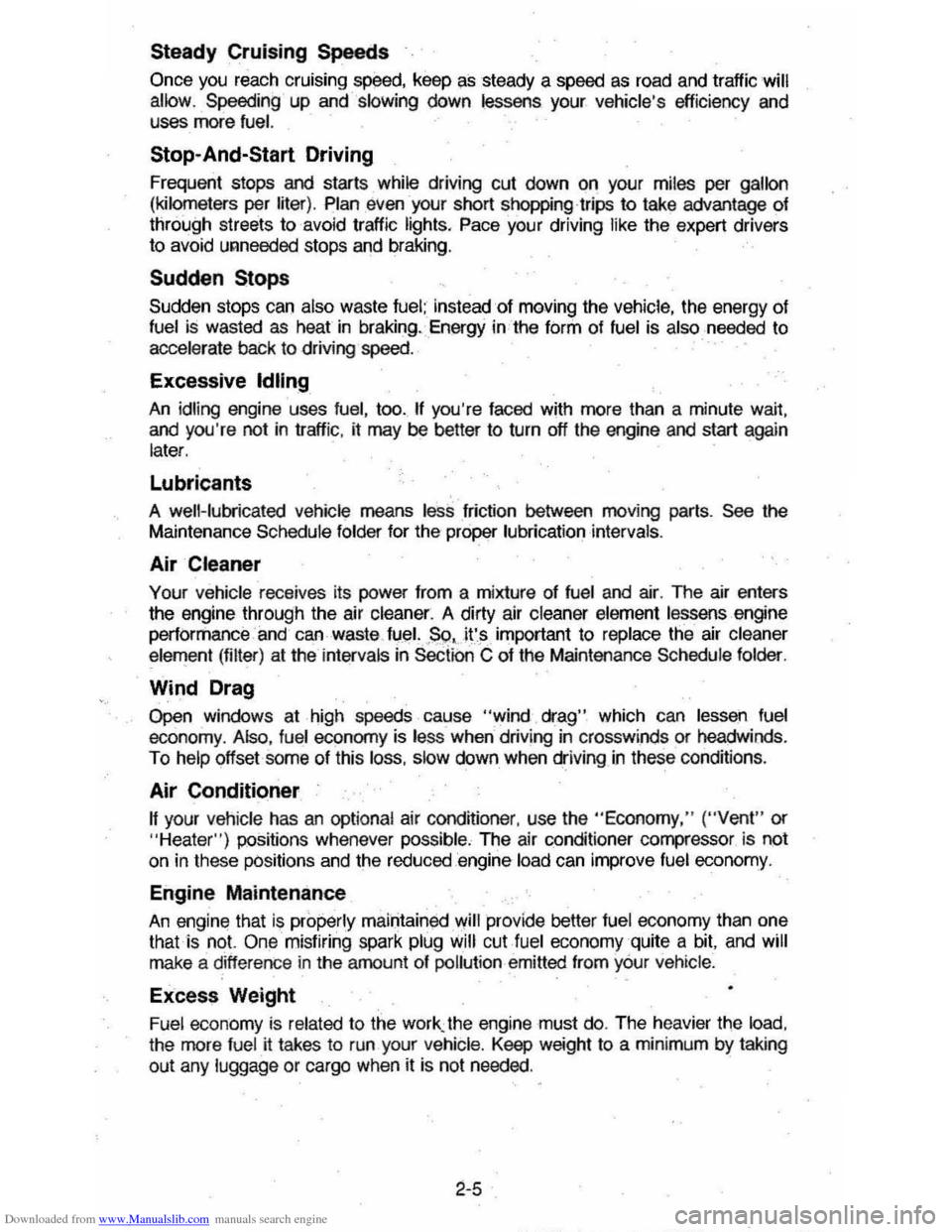
Downloaded from www.Manualslib.com manuals search engine Steady Cruising Speeds
Once you reach cruising sPeed, keep as steady a speed as road and traffic will allow . Speeding up and slowing down lessens your vehicle's efficiency and uses more fuel.
Stop-And-Start Driving
Frequent stops and starts while driving cut down on your miles per gallon
(kilometers per liter) . Plan even your short shopping trips to take advantage of
through streets to avoid traffic lights. Pace your driving
like the expert drivers
to avoid unneeded stops and braking .
Sudden Stops
Sudden stops can also waste fuel; instead of moving the vehicle, the energy of fuel is wasted as heat in braking. Energy in the fOrm of fuel is also needed to
accelerate
baCk to driving speed.
Excessive Idling
An idling engine uses fuel, too .. If you're faced with more than a minute wait,
and you're not in traffic , it may be better to turn off the engine and start again
later.
Lubricants
A well-lubricated vehicle means less friction between moving parts. See the Maintenance Schedule folder for the proper lubrication intervals.
Air Cleaner
Your vehicle receives its power from a mixture of fuel and air. The air enters
the engine through the air cleaner. A dirty air cleaner element lessens engine
perfOrrnance and can waste/Uel. ,So, it's important to replace the air cleaner
element (filter) at the intervals in Section C of the Maintenance Schedule folder .
Wind Drag
Open windows at high speeds cause "wind drag" which can lessen fuel
economy. Also, fuel economy is less when driving in crosswinds or headwinds .
To
help offset some of this loss, slow down when driving in these conditions.
Air Conditioner
" your vehicle has an optional air conditioner , use the "Economy, " ("Vent" or
"Heater") positions whenever possible. The air conditioner compressor, is not on in these positions and the reduced ,'engine-load can improve fuel economy.
Engine Maintenance
An engine that i. properly maintained ."iill provide better fuel economy than one
that is no\.
One misfiring spark plug will cut .fuel economy quite a bit, and will make a difference in the amount of pollution emitted from yOur vehicle.
Exces~ Weight
Fuel economy is related to the work. the engine must do. The heavier the load,
the more fuel it takes to run your vehicle. Keep weight to a minimum by taking
out any luggage or cargo when it is not needed.
2-5
._ - ---_._---'----
Page 36 of 104
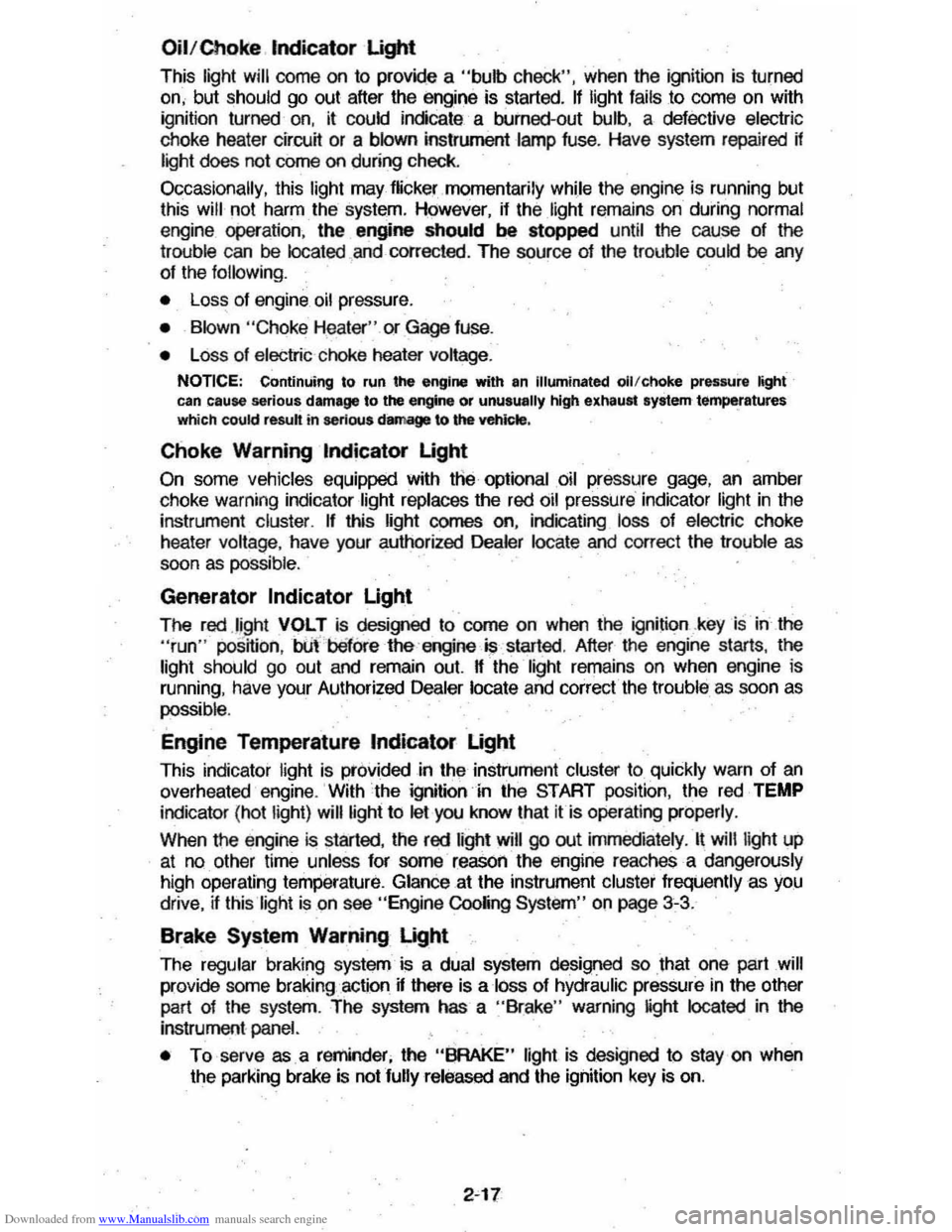
Downloaded from www.Manualslib.com manuals search engine Oil! Choke Indicator Light
This light will come on to prov~ a "bulb check", when the ignition is turnee
on, but should go out after the engine is startee. If light fails to come on with
ignition turnee on,
it could indicate a bumee -out bulb , a defective electric
choke heater circuit or a
blown instrument lamp fuse. Have system repairee if
light
does not come on during check.
Occasionally, this light may flicker . momentarily while the engine is running but
this will· not harm ,the ' system. However, if the ,light remains on during normal
engine operation , the engine shoutd be stopped until the cause of the
trouble can be Iocatee .andcorrectee. The source of the troubte could be any of the following.
•
Loss of engine oil pressure.
• Blown "Choke Heater" or Gage fuse.
• Loss of electric choke heater vo~age.
NOTICE: Continuing to run the engine with an illuminated oil/choke pressure light can cause serious damage to the engine or unusually high exhaust system temp*'ratures which could resuh in serious d8mage to the vehicte.
Choke Warning Indicator Light
On some vehicles equippec with tlie optional .Oil pressure gage, an amber
choke warning indicator
-light replaces the red oil pressure ' indicator light in the
instrument cluster. If this light comes on, indicating loss of electric choke
heater voltage , have your authorizee
Oealer locate and correct the trouble as
soon as possible.
Generator Indicator Light
The red .light VOLT is designee to come on when the ignition.key is in the "run " pos~ion,bul t>efiJrethe 'engine;;, startee. After the engine starts, the
light should go out and remain oul.
H the light remains on when engine is
running , have your Authorized Dealer locate and correct ' the trouble as soon as
possible .
Engine Temperature Indicator Light
This indicator light is providee .in the instrument cluster to. quickly warn of an
overheated engine. 'With the ignition in the START position, the ree TEMP
indicator (hot light) will light to
let you know that it is operating properly.
When the engine is starlee,
the ree light will go out immediately. tt will light up
at no other time unless for some
reason the engine reaches a dangerously
high operating temperature. Glance .at the instrument cluster freqtJentiyas you
drive, if this light is on see
"Engine Cooing System" on page 3,3.
Brake System Warning Light
The regular braking system is a dual system designee so that one part will
provide some braking action
n there is a loss of hydraulic pressure in the other
part of the system. The system has a "Brake" warning Ught Iocatee in the
instrument · panel.
• To serve as a reminder, the "6RAKE" light is designee to stay on when
the parking brake is not fully released and the ignition key is on.
Page 37 of 104
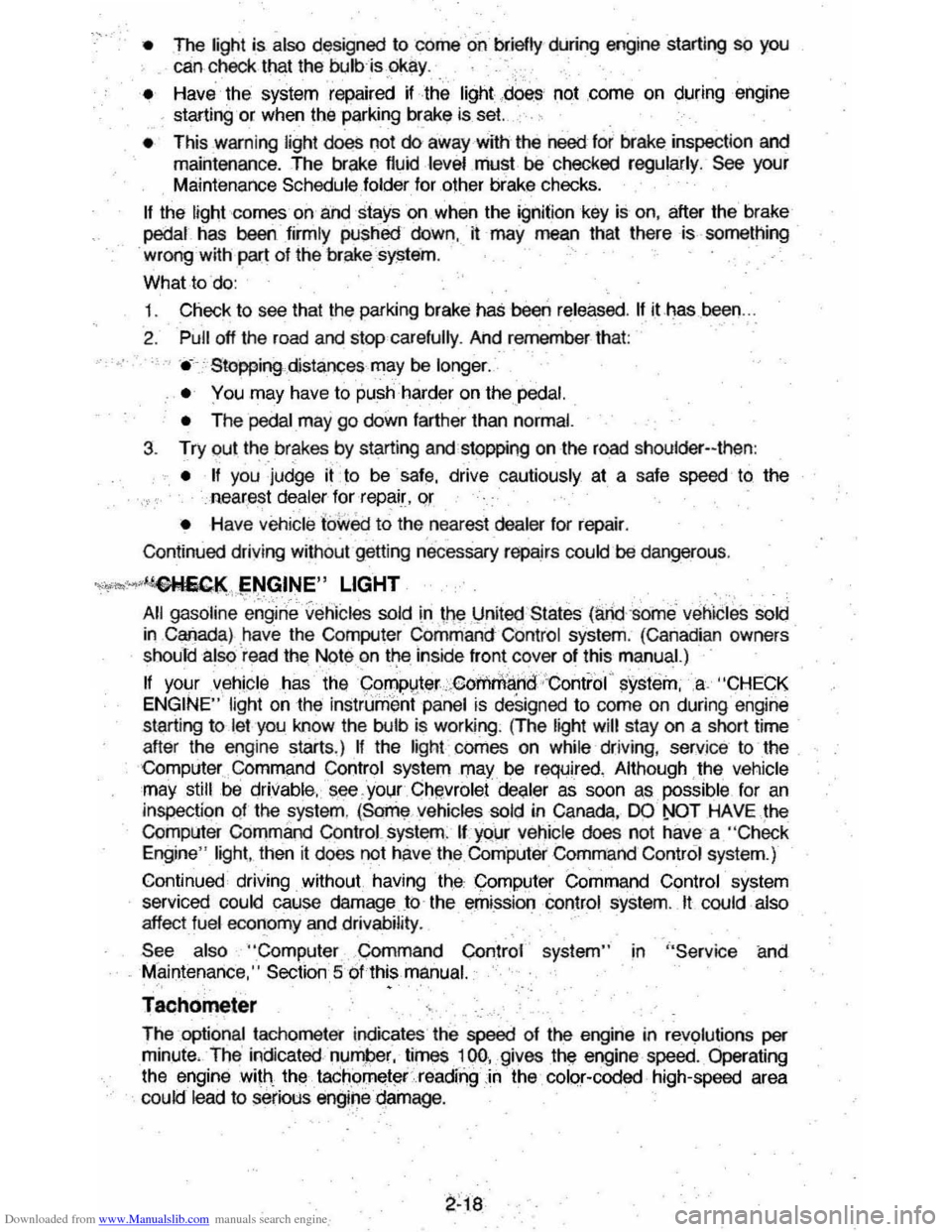
Downloaded from www.Manualslib.com manuals search engine "
• The lighl is also designed to come oi, briefly during engine starting so you . can check that the bulb is okay .
• Have the system repaired ifth'e light .d~es· not .come on during engine
. starting or when th.e Parking brake is set.
•
This warning light does not do away with the heed for brake inspection and
maintenance. The brake fluid level must be checked regularly . See your
Maintenance
Schedule folder for other brake checks.
If the light 'comes on andstavson when the ignition key is on, after the brake pedal has been firmly pushed down, it may mean that there is somelhing
'
wrongwith I?"" of the br"kesyjitem.
What to do:
1. Check to see that the parking brake hec been released . If it has been ..
2. Pull off the road and stop carefully, And remember that:
" .• " Stopping ,distances may be longer.
•
You may have to push harder on the pedal.
•
The pedal may go down farther than normal.
3, Try out the brakes by starting and stopping on the road shoulder--then:
• If you judge it to be safe, drive cautiously at a safe speed to the .near,est dealer for ,repair, or
• Have vooicle t6w~ to the nearest dealer for repair.
Continued driving without getting necessary repairs could be dangerous .
"'''''''~''., ENGINE" LIGHT
All gasoline"~~gine VehiCles sold in ttwl,lnited States (aridsorne ' vehidle. sok:!
in Canada) have the Computer Command Control sYstem, (canadian owners
should
also ' read the Nole on the. inside front cover of this manual. )
If your vehicle has thElCoTP\Jter :,eommand:'ContrOI-system, ,a , "CHECK
ENGINE" light
on the instrument panel is designed to come on during engine
starting to let you know the bulb is working ; (The light will stay on a short time .
after
the engine starts,) If the light comes on while driving, service to the
Computer , Command
Control system may be required , Although. the. v.ehicle
may still be drivable, see , your Chevrolet dealer as soon as possible . for an inspection of the system , (Some vehicles sold in Canada, DO NOT HAVE the
Computer Command Controtsystem ,
ILyeur vehicle does not have a "Check
Engine " light, then it does not have the Computer Command Control system,)
Continued, driving without having the Computer Command Control system
serviced
could cause damegeto' the emission control system, It could also affect fuel economy and drivability, .
See also "Computer
Command Control' system" in "Service and Maintenance," Section: 5 of this manual.
Tachometer
The optional tachometer i. ndicates the speed of the engine in revolutions per
minute, The' indicated num,ber, times 100, gives the engine speed, Operating
the engine
with. the tachometer . reading .in the colQr-coded high-speed area could lead to seriOUS engine damage,
Page 38 of 104
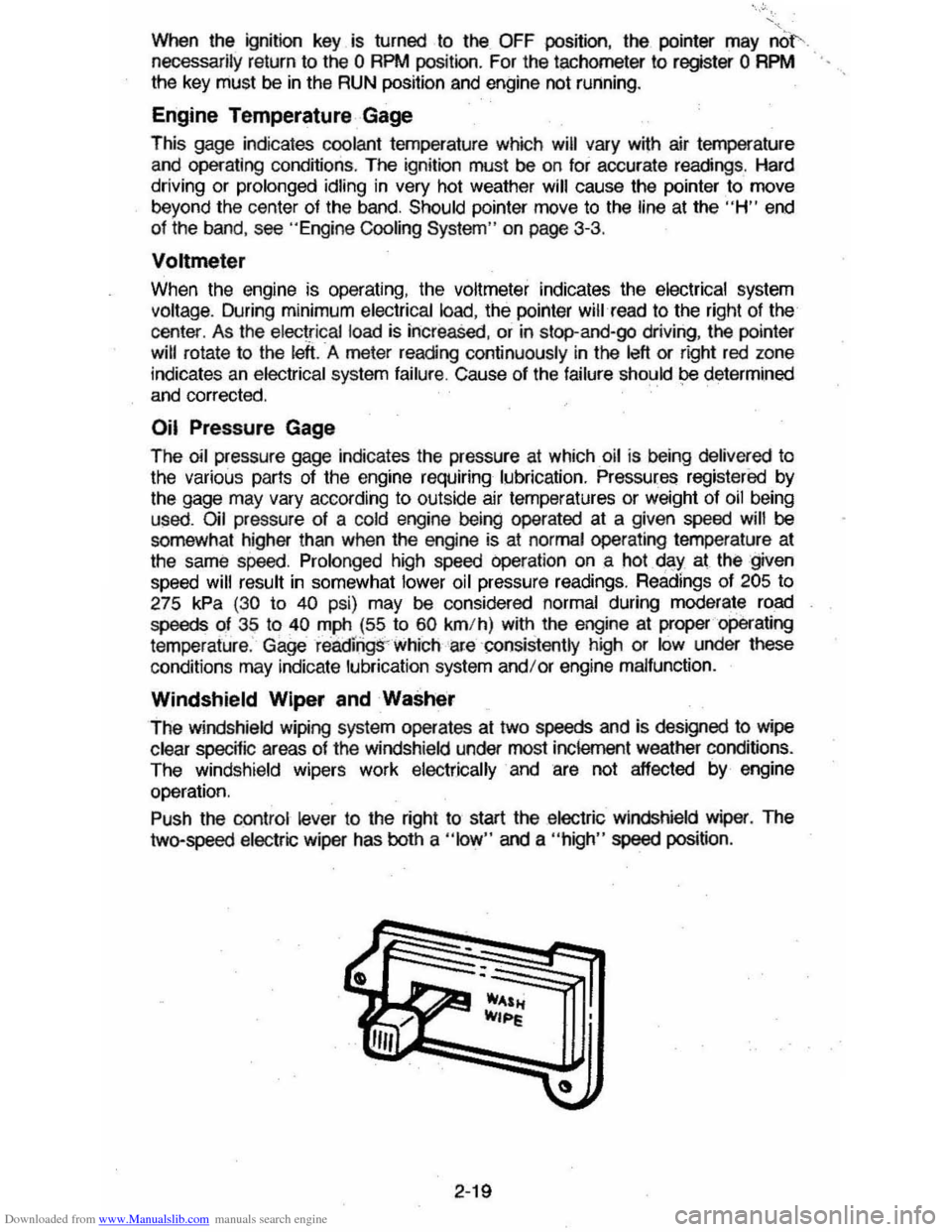
Downloaded from www.Manualslib.com manuals search engine When the ignition key is turned to the OFF position, the pointer may nO\". necessarily return to the 0 RPM position. For the tachometer to regster 0 RPM .
the key
must be in the RUN position and engine not running.
Engine Temperature Gage
This gage indicates coolant temperature which will vary with air temperature
and operating
cond~ions. The ignition must be on for accurate readings. Hard
driving
or prolonged idling in very hot weather will cause the pointer to move
beyond the center of the band. Should pcinter move to the line at the "H" end
of the band , see "Engine Cooling
System" on page 3-3.
Voltmeter
When the engine is operating, the voltmeter indicates the electrical system
voltage. During minimum electrical load, the pointer will read
to the right of the
center. As the electrical load is
increaSed, or in stop-and-go driving, the pointer
will rotate to the
left . A meter reading continuously in the left or right red zone
indicates an electrical system failure. Cause of the failure should be determined
and corrected.
Oil Pressure Gage
The oil pressure gage indicates the pressure at which oil is being delivered to
the various parts of the engine requiring lubrication. Pressures registered by the gage may vary according to outside air temperatures or weight of oil being
used. Oil pressure
of a cold engine being operated at a given speed will be
somewhat higher than when the engine is at normal operating temperature at
the same speed. Prolonged high speed operation on a hot day at the given
speed will result
in somewhat lower oil pressure readings. Readings of 205 to
275 kPa (30 to 40 psi) may be considered normal during moderate road
speeds of 35 to 40 mph (55 to 60 km/h) with the engine at proper operating
temperature . Gage readi'rig;rwhich are ·consistently high or low under these
conditions may indicate lubrication system and/or engine malfunction.
Windshield Wiper and Washer
The windshield wiping system operates at two speeds and is designed to wipe
clear
specijic areas of the windshield under most inclement weather conditions.
The windshield wipers work electrically and are not affected by engine
operation .
Push the control lever to the right to start
the electric windshield wiper. The
two-speed electric wiper has both a "low " and a "high " speed position .
2-19
Page 53 of 104
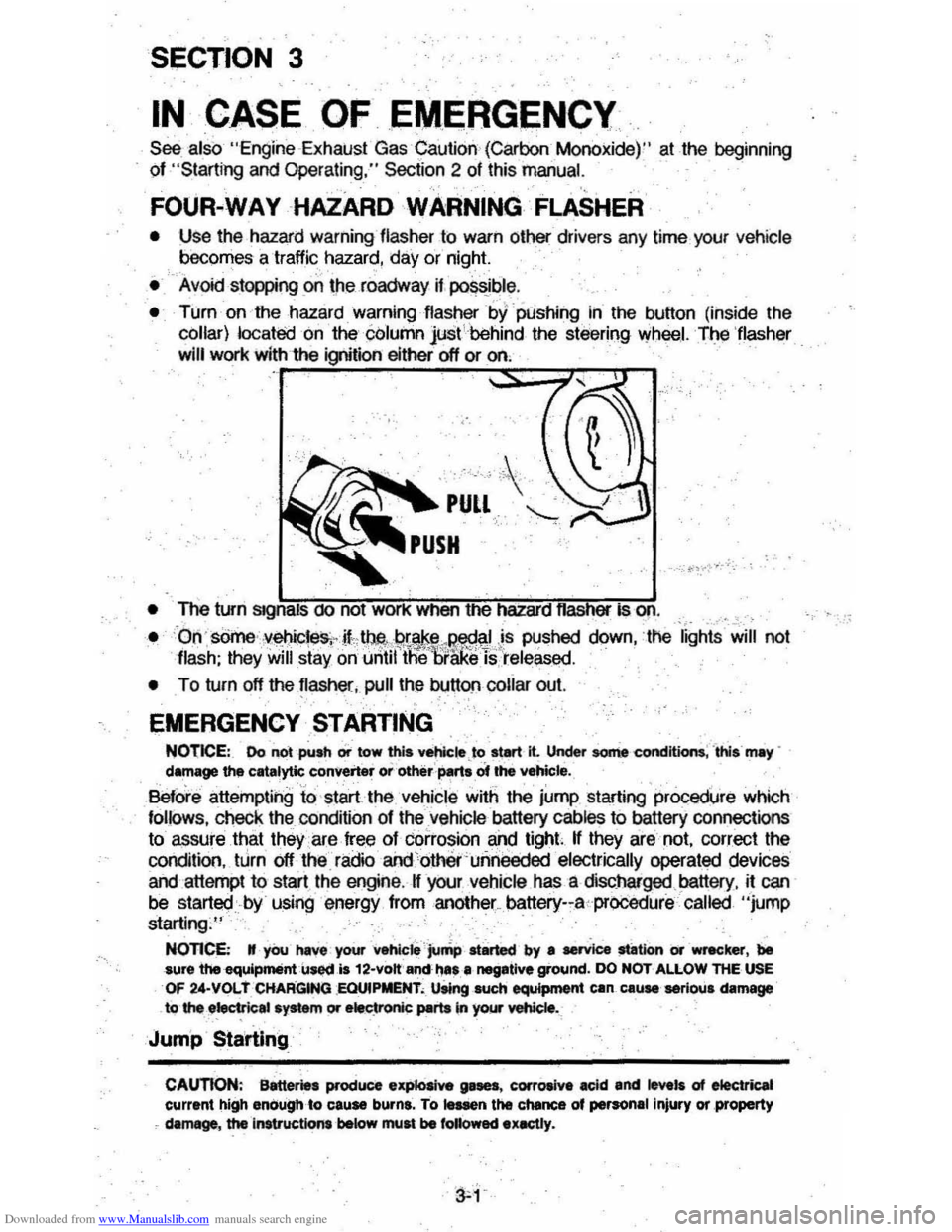
Downloaded from www.Manualslib.com manuals search engine SECTION 3
IN CASE OF ,EM,ERGENCY
See also "Engine ,ExhausIGas Caution (Carbon Monoxide)" at the beginning
of
"Starting and Operating ." Section 2 of this manual.
FOUR.WAYHAZARD WARNING FLASHER
• Use the hazard warning flasher to warn other drivers any time your vehicle
becomes a traffic hazard , day or night
• 'Avoid stopping 00 the roadway if. possible .
•
Turn on ·the haz,ard warning flasherb{ pushing In the button (inSide the COllar) located on the cOlumn just'behind the steering whee ,l. The 'flasher wUl work with1he ignition either off or on,
",'
• The turn SIgnalS ao not wOl1< wnen me hazard flasher is on,
• 'On·$ome·,V:!>tJiC~S;,j\tj:l~i9[~~",~}S pushed down,the fights will not
flash; they will stay on utitiltne 'Brake iS,'released , ,
•
To turn off the flasher . pull the buttOflcoliar out.
EMERGENCY STARTING
NOtICE:. Do not-~.h oi tow this -Y~le_to stlW1 it. Under some cond~: "this-may· d.~a,ge the catalytic e,onverter or'other:~rt~ofthe vehicle.
Before attempting to' start. the vehicle with the jump starting 'procedUre which
tollows, check the condition of the vehicle battery cables to battery connections
to
8$sure that, theye,e free of corro~i(>n an,d tight, n they are not. correct the, condition . tJrn off the radio and ,'ot1\
II your vehicle has a discharged , battery. it can
be started ,bY' using energy from anotheL battery-,a,,'prQCedure 'called "jump starting ,'" ,
NOTICE; II yiK'-haVe yoUr 'vehiclt"'jU4 .flirted by. "";kie _Uon or 'wrecker. be sur. iheequlpm8ntu~ ,is 12-yott and' ~":' neg.tlve ground. DO NOT · ALLOW THE USE OF 2A-VOL t 'CHAR'GINO .EOlHPMENT,,_ uSingsucti equipment cn cau .. serioUl damage to the e~ar system Of efre%nic~rta in your V'8hide._
Jump Starting
CAUTION: Better •• produce expJOlive gnea , corroaive acid and "vela of electrical current high enough 10 cause burns. To IeUen the chance of person.1 injury or property -damage, the Instruction, below must be fOllowed ex.ctly.
"
Page 55 of 104
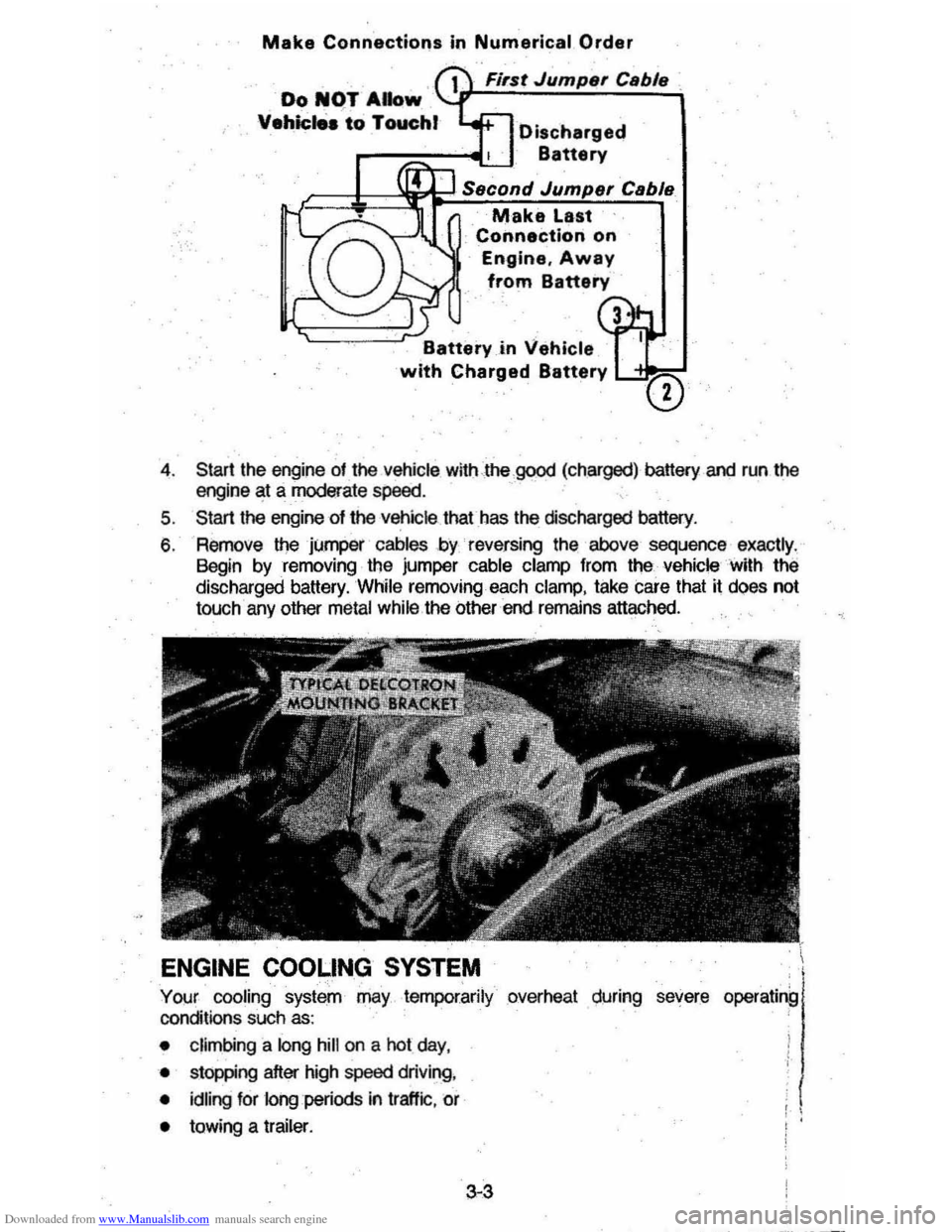
Downloaded from www.Manualslib.com manuals search engine Make Connections in Numerical Order
Fi,st Jumpe, Ceble ,
Discharged
Battery
Make Last
Connection on
Engine,
Away
from Battery
Battery in Vehicle
with Charged Battery L--'''''''",,""
4. Slarllhe engine 01 the vehicle withJhe .good (charged) battery and run the
engine at a moderate speed.
5 .
Start the engine of the vehicle thathas the discharged battery.
6 . Remove the jumper
cables .by reversing the above sequence exactly.
Begin by removing the jumper
cable clamp from the vehiclewilh tM
discharged battery. While removing each clamp, lake care that it does not
touch any other
metal while the other end remains attached.
Your cooling system may temporarily overheat during severe
conditions such as:
• climbing a long hill on a hot day,
• stopping after high speed driving ,
• idling for long periods in traffic, or
• tawing a trailer.
3-3
Page 56 of 104
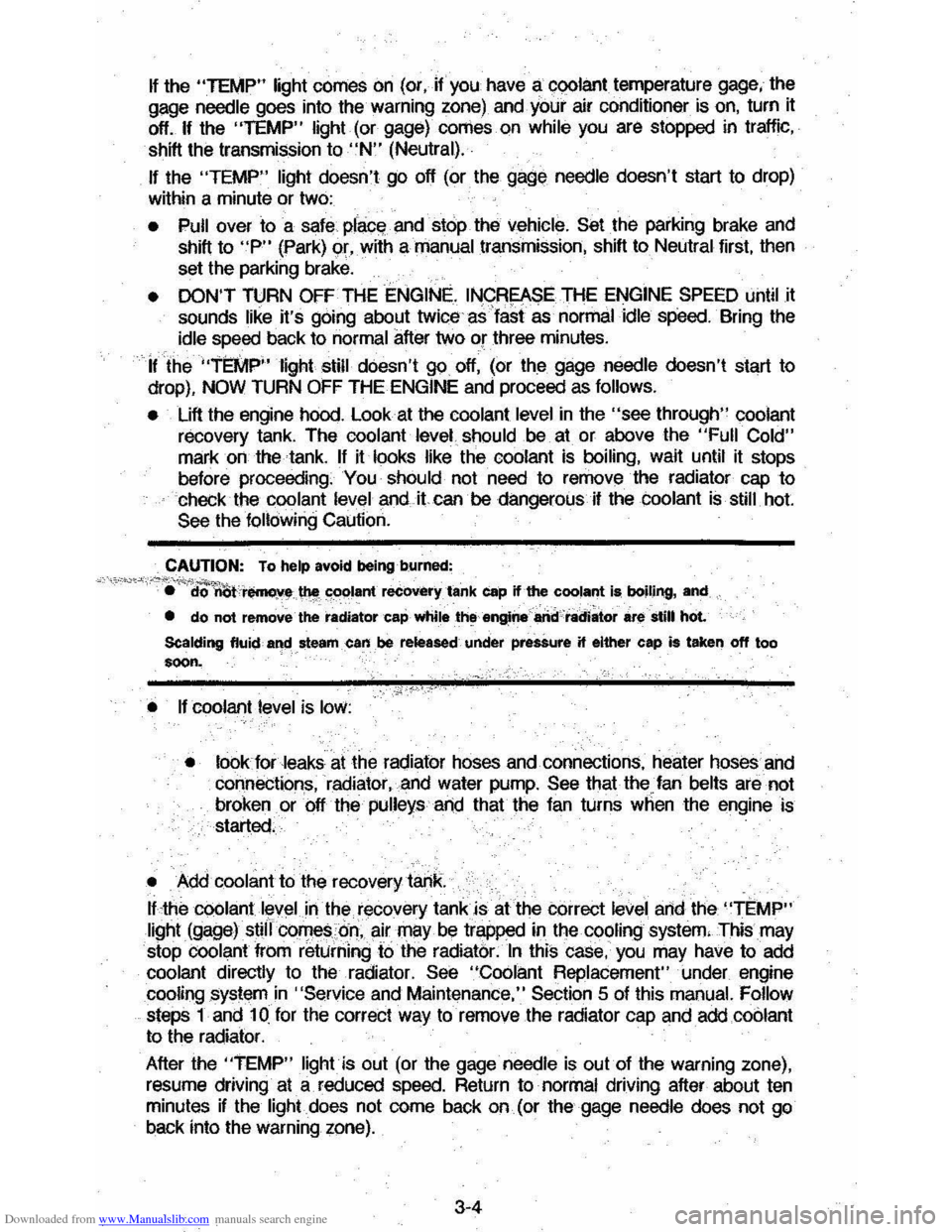
Downloaded from www.Manualslib.com manuals search engine "the "TEMP" light comes on (or, if you have a 900lant temperature gage, the
gage needle goes into the warning zone) and your air conditioner is on, turn it
off.
If the "TEMP" light (or gage) comes on while you are stopped in traffic,
shift the transmission to
"N" (Neutral).
If the "TEMP" light doesn't go off (or the gage needle doesn't start to drop)
within a minute or two:
• Pull over to a safe Place ""d stop the vehicle. Set the parking brake and
shift to "P" (Park) 9r, with a manual transmission, shift to Neutral first, then
set the parking brake.
• DON'T TURN OFF THE ENGINE. INCREASE THE ENGINE SPEED until it
sounds like it's going about twice as fast as normal idle speed. Bring the
idle speed back to normal
after two or three minutes.
tfthe "TEMP" light still doesn't 90 off, (or the gage needle doesn't start to
drop),
NOW TURN OFF THE ENGINE and proceed as follows.
•
lift the engine hood. Look at the coolant level in the "see through" coolant
recovery tank. The coolant level. should be at or above the "Full Cold"
mark on the tank. If it looks like the coolant is boiling, wait until it stops
before proceeding. You should not need to remove the radiator cap to
check the coolant
level and. it can be dangerous if the coolant is still hot. See the following Caution.
CAUTION: To help avoid being burned:
"'-'''''''''i',",,;0-Fc:io'ffi)tcremoy'J~_ c;<)olant recovery tank cap if the coolant is boiling, and
• do not remove -the radiatorc:ap WhilethIit8ngine'-aUid:radiltor a,.Slili hot.
Scalding fluid and steamean be released under pressure it either cap is taken off too soon,
-;<
• If coolant level is low:
•
looklorleaks at the radiator hoses and connections, heater hoses and
connections,
r"diator,and water pump. See that the. fan belts are not
broken or off the pulleys an.d that the fan turns when the engine is started,
•
Add coolant to the recovery tahk.
If
the cQolant level in the recovery tank is althe correct lellel arid the "TEMP"
light (gage) still co"",s.dn,. air may be tr~ in the cooling system, This may
stop coolant from returning to the radiator. In this case, you may have to add
coolant directly to the radiator.
See "Coolant Replacement" under engine
cooling system
in "Service and Maintenance," Section 5 of this manual. Follow
steps 1 and 10. for the correct way to remove the radiator cap and add .coolant
to the radiator.
After the
"TEMP" light is out (or the gage needle is out of the warning zone),
resume driving at a reduced speed. Return to normal driving after about ten
minutes if the light does not come back
on (or the gage needle does not go
back into the warning zone).
3-4